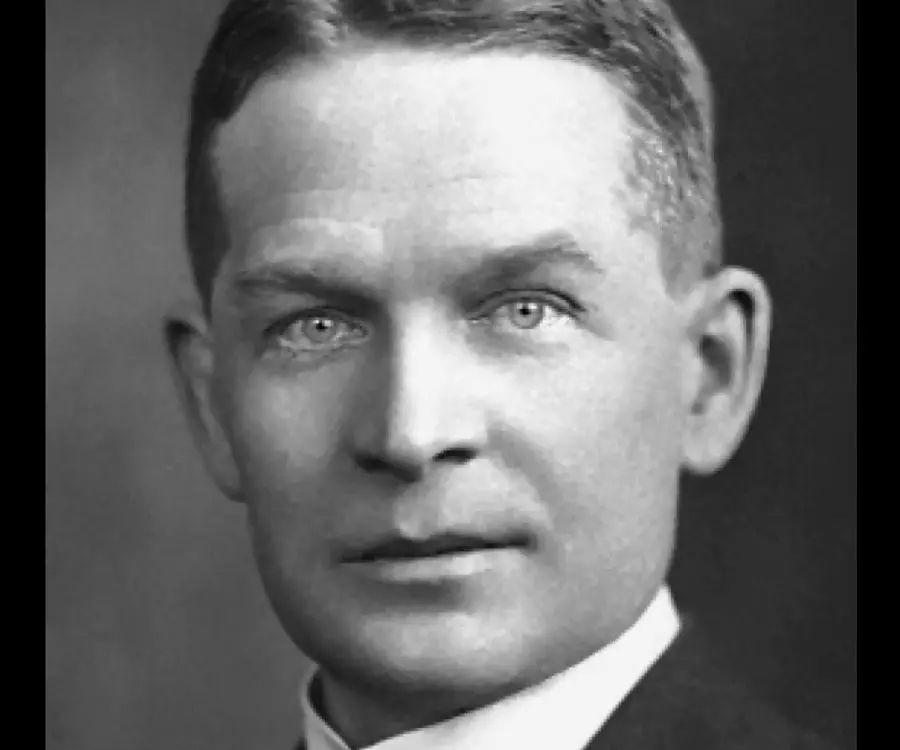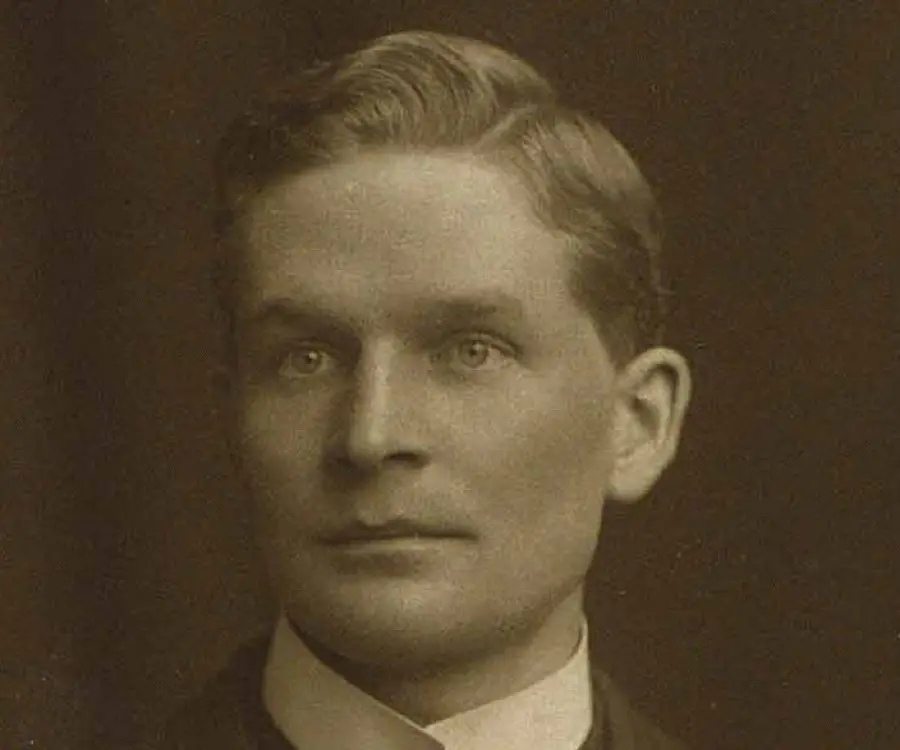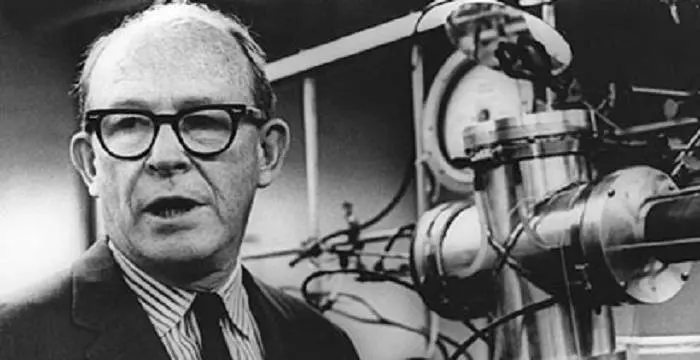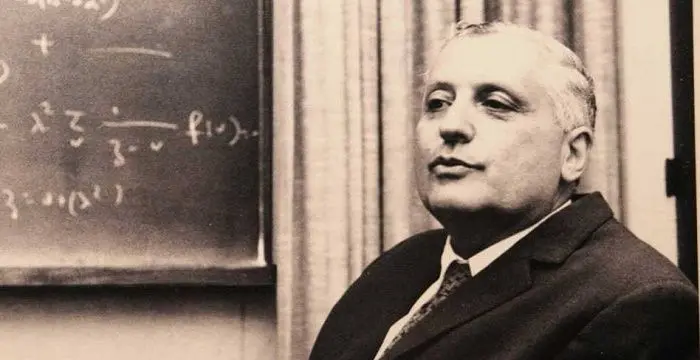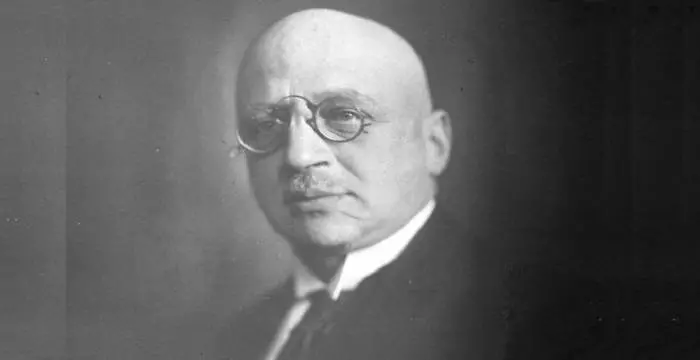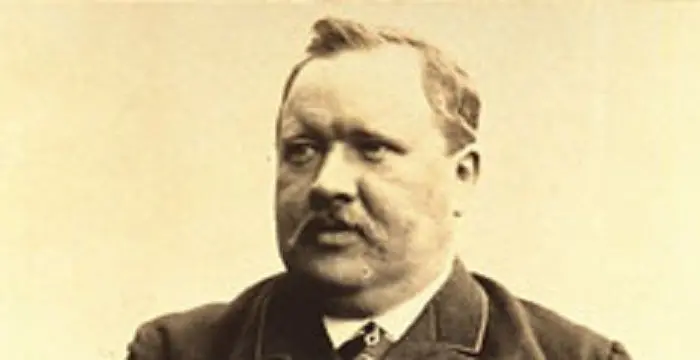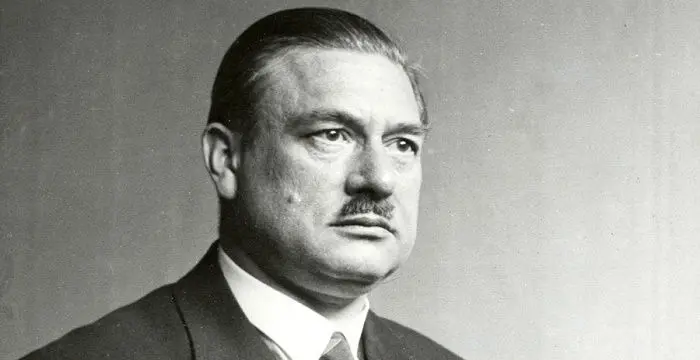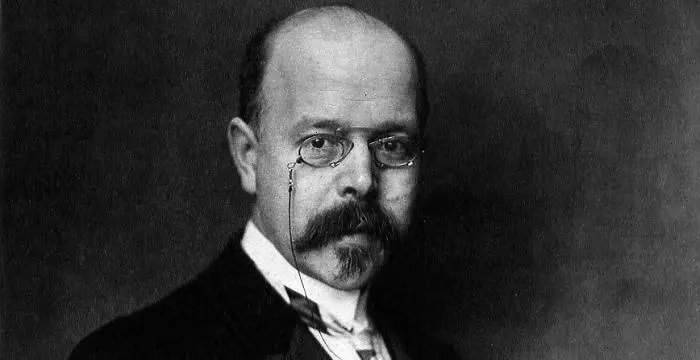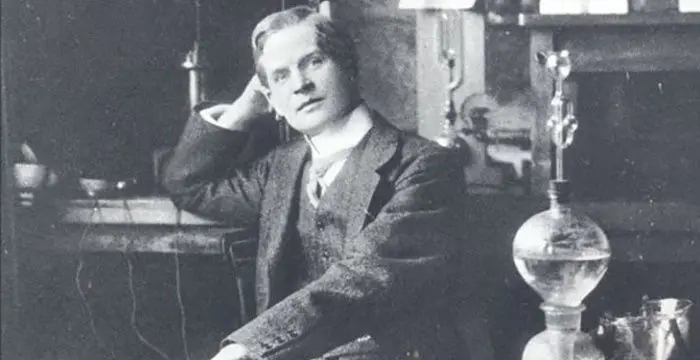
Frederick Soddy - Radiochemist, Facts and Facts
Frederick Soddy's Personal Details
Frederick Soddy was a British radiochemist who won the Nobel Prize in Chemistry in 1921
| Information | Detail |
|---|---|
| Birthday | September 2, 1877 |
| Died on | September 22, 1956 |
| Nationality | British |
| Famous | Scientists, Chemists, Physical Chemists, Radiochemist |
| Known as | Содди, Фредерик |
| Universities |
|
| Birth Place | Eastbourne |
| Gender | Male |
| Sun Sign | Virgo |
| Born in | Eastbourne |
| Famous as | Radiochemist |
| Died at Age | 79 |
Frederick Soddy's photo
Who is Frederick Soddy?
Frederick Soddy was a British radiochemist who won the Nobel Prize in Chemistry in 1921. Educated at Merton College Oxford, he started his career at McGill University in Montreal and with Ernest Rutherford established the ‘Theory of Atomic Disintegration’. Later he joined Sir William Ramsay at University College London and together they demonstrated that radioactive disintegration of radium bromide produces helium. During his long career, he also proposed ‘Displacement Theory’ and discovered protactinium. However, formulation of the concept of isotopes was his most significant work. Much later, he received the Nobel Prize in Chemistry for it. Interestingly, towards the end of his life he lost interest in chemistry and began to write on economic, social and political problems. He not only campaigned for total restructuring of global monetary system, but was also angry that the world’s economic system failed to take the advantage of scientific advancemnent. However, his theories in these regards remained unacceptable at least during his lifetime. He was said to be a man of strong principles. Many found his views to be rather obstinate and his nature prickly. However, he was quite friendly to his students and was very popular among them.
// Famous Scientists
Juliane Koepcke
Juliane Koepcke is a German-Peruvian biologist, who was the lone survivor among the 92 passengers and crew of the ill-fated LANSA Flight 508 that crashed in the Peruvian rainforest on 24 December 1971. Know more about her life in this biography.
Henry Cavendish
Henry Cavendish was a theoretical chemist and physicist, renowned for discovery of hydrogen and calculation of the mass of earth. To know more about his childhood, profile, timeline and career read on
Konstantin Tsiolkovsky
Konstantin Tsiolkovsky was a Russian rocket scientist and a pioneer of astronautics. This biography provides detailed information about his childhood, family, personal life, career, achievements, etc.
Childhood & Early Life
Frederick Soddy was born on 2 September 1877 in Eastbourne, a seaside resort in Sussex, England. His father, Benjamin Soddy, was a corn merchant in London. Frederick was the youngest of his father’s seven children. His mother died when he was two years old and he was raised by a half sister.
Young Soddy had his schooling at Eastbourne College. Later he got admitted to University College of Wales at Aberystwyth. In 1895, he received a scholarship and shifted to Merton College, Oxford; ultimately passing out from there in 1898 with first class honors in chemistry.
Career
In 1898, Frederick Soddy began his career as an independent researcher at Oxford. In 1900, he shifted to Canada and there he became a demonstrator in chemistry at McGill University in Montreal. Soon, he came in contact with Ernest Rutherford, who asked him to identify the thorium emanations.
Soddy and Rutherford worked together for two years on thorium and discovered a highly radioactive substance called thorium-X. They then kept on experimenting on different radioactive elements and finally in 1902, established the ‘Theory of Atomic Disintegration’.
They proposed that radioactivity was an atomic phenomenon and that radioactive emission occurs when chemical transmutations of the atoms take place. Later they demonstrated that radioactive elements behave anomalously because they have a propensity to decay and form other elements.
They also noted that such decay produces alpha, beta and gama radiation. Moreover, they also noticed gaseous emanation from thorium, but could only conclude that it was an inert gas.
Subsequently, Soddy went back to England to work with Sir William Ramsay at University College London. That was mainly because Ramsay’s laboratory was at that time the only place where he could successfully examine minute amount of rare gases.
Here he continued to study radium emanation and in July 1903, showed experimentally that helium is produced when radium bromide is decayed radioactively. He also concluded that the gas originated in the alpha particles. Thus he guessed that they were helium nuclei.
In 1904, Soddy was appointed as a lecturer in physical chemistry and radioactivity in the University of Glasgow. He immediately started experimenting in the later field. The first few years were spent in purifying radioactive materials.
In 1910, he turned his attention to short lived radio elements. In this, he collaborated with Alexander Fleck and established that in many cases a number of intermediates were not only chemically same, but was also inseparable; yet they go through radioactive decay differently.
He continued working on the puzzle and subsequently established that emission of an alpha-particle from an element causes that element to move back two places in the Periodic Table. Contrarily, beta emission causes the element to go up one place in the same table.
In 1913, he joined the two theories to propose his ‘Displacement Law’. In the same year, he also proposed that certain elements exist in two or more forms, which might be chemically indistinguishable and inseparable, but may have different atomic weight. He called them isotopes
In 1914, Soddy shifted to the University of Aberdeen as a Professor of Chemistry. However, as the First World War broke out, he could not continue with his research as his laboratory started being used for war oriented experimentations.
In spite of such restrictions, Soddy along with John Arnold Cranston discovered the stable isotope of Protactinium. It is believed that they had actually discovered it in 1915, but could publish the paper only in 1918 as Cranston was drafted into military service and the note remained locked up in his laboratory.
In 1919, Soddy joined the University of Oxford as Lee’s Professor of Inorganic and Physical Chemistry; a position he held until his retirement in 1937. Although he reorganized the chemistry syllabus and the laboratories, he did little personal research.
He now began to show more interest in economic, social and political dilemmas as well as in different mathematical and economical problems. At the same time, he continued with his writing works. His ‘Interpretation of the Atom’ was published in 1932.
Major Works
Frederick Soddy is best remembered for his discovery of isotopes. The underlying concept of this discovery is that different elements with different atomic weight but identical chemical characteristics might be assigned to the same chemical space. He later named these elements isotopes, which in Greek means ‘the same place’, on the advice of family friend Dr. Margaret Todd.
In addition, Soddy had number of books to his credit. Apart from the above mentioned ‘The Interpretation of the Atom’, some of his more important works are 'Radioactivity’, ‘The Interpretation of Radium’, ‘The Chemistry of the Radioactive Elements’, ‘Matter and Energy’, ‘Science and Life’, ‘The Story of Atomic Energy’, and ‘Atomic Transmutation’.
Awards & Achievements
Frederick Soddy was awarded the Nobel Prize in Chemistry in 1921 for his contributions to the knowledge of the chemistry of radioactive substances, and his investigations into the origin and nature of isotopes".
in 1922, Soddy became a member of International Atomic Weight Committee. Earlier in 1910, he was elected a Fellow of Royal Society.
Personal Life & Legacy
In 1908, Soddy married Winifred Beilby, the daughter of renowned Chemist, Sir George Beilby. The couple did not have any children. If hearsays are to be believed it was Winifred’s death that led to his disenchantment with experimental science and he retired prematurely. He died on September 22, 1956 at Brighton.
A small crater on the moon has been named after Fredrick Soddy. Soddyite, a radioactive Uranium mineral, also bears his name.
Trivia
The International Union of Pure and Applied Chemistry would have liked to name an element after Soddy. However, the phonetic similarity of his name to sodium deterred them from carrying it out.
// Famous Chemists
Henry Cavendish
Henry Cavendish was a theoretical chemist and physicist, renowned for discovery of hydrogen and calculation of the mass of earth. To know more about his childhood, profile, timeline and career read on
Walter Kohn
Nobel Laureate Walter Kohn was an Austrian-born American theoretical chemist and physicist. Check out this biography to know about his childhood, life, achievements, works & timeline.
Jabir Ibn Hayyan
Jabir Ibn Hayyan was a medieval era polymath. Check out this biography to know about his life, works and achievements.
Frederick Soddy's awards
| Year | Name | Award |
|---|---|---|
Other | ||
| 0 | Nobel Prize in Chemistry | |
Frederick Soddy biography timelines
- // 2nd Sep 1877Frederick Soddy was born on 2 September 1877 in Eastbourne, a seaside resort in Sussex, England. His father, Benjamin Soddy, was a corn merchant in London. Frederick was the youngest of his father’s seven children. His mother died when he was two years old and he was raised by a half sister.
- // 1895 To 1898Young Soddy had his schooling at Eastbourne College. Later he got admitted to University College of Wales at Aberystwyth. In 1895, he received a scholarship and shifted to Merton College, Oxford; ultimately passing out from there in 1898 with first class honors in chemistry.
- // 1898 To 1900In 1898, Frederick Soddy began his career as an independent researcher at Oxford. In 1900, he shifted to Canada and there he became a demonstrator in chemistry at McGill University in Montreal. Soon, he came in contact with Ernest Rutherford, who asked him to identify the thorium emanations.
- // 1902Soddy and Rutherford worked together for two years on thorium and discovered a highly radioactive substance called thorium-X. They then kept on experimenting on different radioactive elements and finally in 1902, established the ‘Theory of Atomic Disintegration’.
- // Jul 1903Here he continued to study radium emanation and in July 1903, showed experimentally that helium is produced when radium bromide is decayed radioactively. He also concluded that the gas originated in the alpha particles. Thus he guessed that they were helium nuclei.
- // 1904In 1904, Soddy was appointed as a lecturer in physical chemistry and radioactivity in the University of Glasgow. He immediately started experimenting in the later field. The first few years were spent in purifying radioactive materials.
- // 1908 To 22nd Sep 1956In 1908, Soddy married Winifred Beilby, the daughter of renowned Chemist, Sir George Beilby. The couple did not have any children. If hearsays are to be believed it was Winifred’s death that led to his disenchantment with experimental science and he retired prematurely. He died on September 22, 1956 at Brighton.
- // 1910In 1910, he turned his attention to short lived radio elements. In this, he collaborated with Alexander Fleck and established that in many cases a number of intermediates were not only chemically same, but was also inseparable; yet they go through radioactive decay differently.
- // 1910 To 1922in 1922, Soddy became a member of International Atomic Weight Committee. Earlier in 1910, he was elected a Fellow of Royal Society.
- // 1913In 1913, he joined the two theories to propose his ‘Displacement Law’. In the same year, he also proposed that certain elements exist in two or more forms, which might be chemically indistinguishable and inseparable, but may have different atomic weight. He called them isotopes
- // 1914In 1914, Soddy shifted to the University of Aberdeen as a Professor of Chemistry. However, as the First World War broke out, he could not continue with his research as his laboratory started being used for war oriented experimentations.
- // 1915 To 1918In spite of such restrictions, Soddy along with John Arnold Cranston discovered the stable isotope of Protactinium. It is believed that they had actually discovered it in 1915, but could publish the paper only in 1918 as Cranston was drafted into military service and the note remained locked up in his laboratory.
- // 1919 To 1937In 1919, Soddy joined the University of Oxford as Lee’s Professor of Inorganic and Physical Chemistry; a position he held until his retirement in 1937. Although he reorganized the chemistry syllabus and the laboratories, he did little personal research.
- // 1921Frederick Soddy was awarded the Nobel Prize in Chemistry in 1921 for his contributions to the knowledge of the chemistry of radioactive substances, and his investigations into the origin and nature of isotopes".
- // 1932He now began to show more interest in economic, social and political dilemmas as well as in different mathematical and economical problems. At the same time, he continued with his writing works. His ‘Interpretation of the Atom’ was published in 1932.
// Famous Physical Chemists
Willard Libby
Willard Frank Libby was an American physical chemist who was awarded the ‘Nobel Prize’ in Chemistry in 1960. This biography profiles his childhood, life, career, research, achievements and timeline.
Ilya Prigogine
Ilya Prigogine was a Russian-born Belgian physical chemist who was awarded the Nobel Prize for Chemistry in 1977. This biography of Ilya Prigogine provides detailed information about his childhood, life, achievements, works & timeline.
Fritz Haber
Fritz Haber was a German chemist who won the 1918 Nobel Prize in Chemistry for the synthesis of ammonia from its elements. Check out this biography to know about his childhood, life, achievements, works & timeline.
Svante Arrhenius
Svante Arrhenius was a renowned Swedish scientist who is regarded as father of modern day physical chemistry. To know more about his childhood, profile, career and timeline read on
Peter Debye
Peter Debye a Nobel Prize winning chemist of Dutch origin who developed the ‘Debye Model’. This biography provides detailed information about his childhood, profile, timeline, and career.
Walther Nernst
Walther Hermann Nernst was a German scientist who won the 1920 Nobel Prize in Chemistry for his contribution to the field of thermochemistry.
Frederick Soddy's FAQ
What is Frederick Soddy birthday?
Frederick Soddy was born at 1877-09-02
When was Frederick Soddy died?
Frederick Soddy was died at 1956-09-22
Where was Frederick Soddy died?
Frederick Soddy was died in Brighton
Which age was Frederick Soddy died?
Frederick Soddy was died at age 79
Where is Frederick Soddy's birth place?
Frederick Soddy was born in Eastbourne
What is Frederick Soddy nationalities?
Frederick Soddy's nationalities is British
What was Frederick Soddy universities?
Frederick Soddy studied at Merton College, Oxford, Aberystwyth University, University of Oxford, Eastbourne College
What is Frederick Soddy's sun sign?
Frederick Soddy is Virgo
How famous is Frederick Soddy?
Frederick Soddy is famouse as Radiochemist
